By Lillian Sizemore, September 26, 2011
I GREW UP VISITING Chicago’s Field Museum—wandering its dark halls, rapt with a combination of fear and curiosity. Remembering the lifelike dioramas, the creepy taxidermy varmints, and massive Tyrannosaurus Rex, I was more-than-intrigued to know that the 2000-year-old ancient mosaic from Lod, Israel would be making an appearance in my hometown during it’s U.S. tour. The traveling mosaic has already drawn record audiences in New York’s Metropolitan Museum and San Francisco’s Legion of Honor.
WITH CHICAGO’S LOD MOSAIC exhibition, opening December 9, 2011, we can expect to see a deeper look into how mosaics can aid the science and understanding of the evolution of the natural world. Since 1893, the Field Museum maintains one of the nation’s premier natural history collections from the far corners of the world. It’s the real life Jurassic Park.
THE LOD mosaic exhibit will be accompanied by many zoological samples and history on the origin of the mammals, birds, and fishes depicted in the mosaic. I’m honored to have been invited to the Field Museum to continue my Visiting Artist work. I will offer an educational display and mosaic demonstrations on SATURDAY DEC. 10 from 11 AM to 3 PM at the Museum’s main Stanley Field Hall.
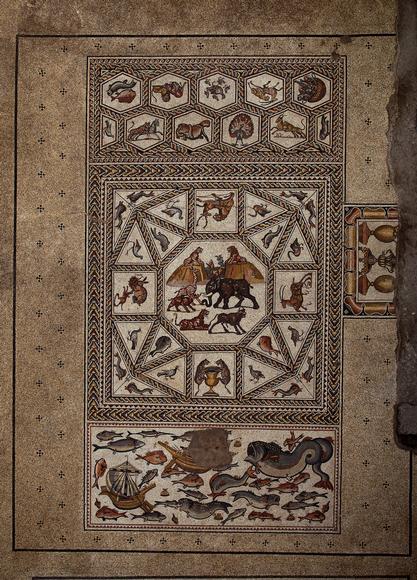
NO HUMAN FIGURES appear in the mosaic, which is unusual for mosaic work from the 3rd century Roman era. It has been dubbed everything from both “the peaceable kingdom” and “savage encounter” by G.W. Bowersock, to the “Marvelous Menagerie” (Dreyfus) to a “Mosaic Rock Star” (Mosaic Art Now).
The Lod Mosaic is one of the world’s best preserved and unique mosaics, depicting exotic animals and fishes contained in precise geometric framing. Measuring over 350 square feet, this ancient Roman mosaic floor was first discovered in 1996 during construction on the Jerusalem-Tel Aviv highway in Lod, Israel. It is a RARE opportunity to see a mosaic of this scale in the U.S.
A RECENT REPORT released by Frontiers in Ecology and the Environment uses ancient mosaics to learn more about the evolution of marine life. Researchers Paolo Guidetti and Fiorenza Micheli examined hundreds of Etruscan, Greek, and Roman mosaics in order to study the 100,000 year-old dusky grouper. Mosaics from ancient times gave scientists a look back into the waters of the Mediterranean basin when they were teeming with thousands of species. The mosaics depict men being eaten and engulfed by the grouper, indicating that the endangered fish used to be MUCH bigger. Often, this image of a man being eaten by a giant fish is interpreted as a biblical reference to the story of Jonah and the Whale. But new science is suggesting that some 2000 years ago, the ancient grouper was indeed a much larger fish, perhaps capable of being a “man-eater”.
A detail of a mosaic from the Bardo National Museum in Tunis. photo E. Trainito
NORTH AFRICAN mosaics in particular, depict sea life and fishing scenes with amazing accuracy. The Lod mosaic is no exception, and it exhibits the stylistic influence of the “Roman North African School” where the diversity of limestone and marble fostered a tradition of polychromatic (multicolored) work. The best examples are now found in the Bardo Museum in Tunis, Tunisia.

Tunisian Basket of Fish mosaic in conservation lab, Getty Villa. Photo by Author
Christopher S. Lightfoot, curator of Greek and Roman Art for New York’s Metropolitan Museum, observes of the Lod:
“…several different types of fish are represented, many of which presumably formed part of the regular diet at least of those who lived close enough to the sea to get fresh fish… The mosaic also depicts several marine mollusks that may be identified as murex and bivalve shells, remains of which are frequently found on ancient sites.
Various species of edible fish may be identified—bream, mullet, sea bass, and snapper—but one long, thin fish (at top left) could be seen as a barracuda and the two larger fish (one about to swallow a smaller fish) near the bottom of the panel are possibly bluefish or amberjacks.
Dominating the right upper part of the mosaic is a very large fish with a long, spiral tail. In all likelihood it represents a whale, which is about to swallow the damaged merchant ship in the center of the panel. The whale has the same curly tail as the ketos on the octagonal medallion on the main panel. [see photo below] The two creatures were often confused and conflated in ancient literature and artistic representations.”

The Lod’s main panel Ketos or Sea Monster. Photo by Author
COULD IT BE that the mosaicists took artistic liberties with the myth and depiction of the “Man-eating Grouper”, and that it’s not meant to be a whale at all? The dorsal fins, along with the spotted scales, would indicate that it is, in fact, not a whale. Given the mosaicist’s penchant for detail, it would appear that these artists were fully acquainted with their fish zoology. The term ketos, is a Greek term for a “huge fish” and in mythological terms it becomes a “Sea Monster” of undefined origin, akin to a sea serpent. Think: Loch Ness Monster. In the Lod Mosaic, perhaps we have the massive grouper depicting a ketos, afterall. The Frontiers in Ecology report states:
Fish depicted in mosaics were often detailed enough to be recognizable as dusky groupers, but unlike today’s animals, the ones depicted were enormous—in one case, large enough to eat a fisherman whole. Though possibly a case of artistic license, the depictions imply that groupers were large enough to be considered “sea monsters”…The dusky grouper has been a popular target for Mediterranean fishermen since prehistoric times; their bones have been found in human settlements dating back more than 100,000 years.”


Detail of Roman fishing scene from the British Museum collection. Photo by Author
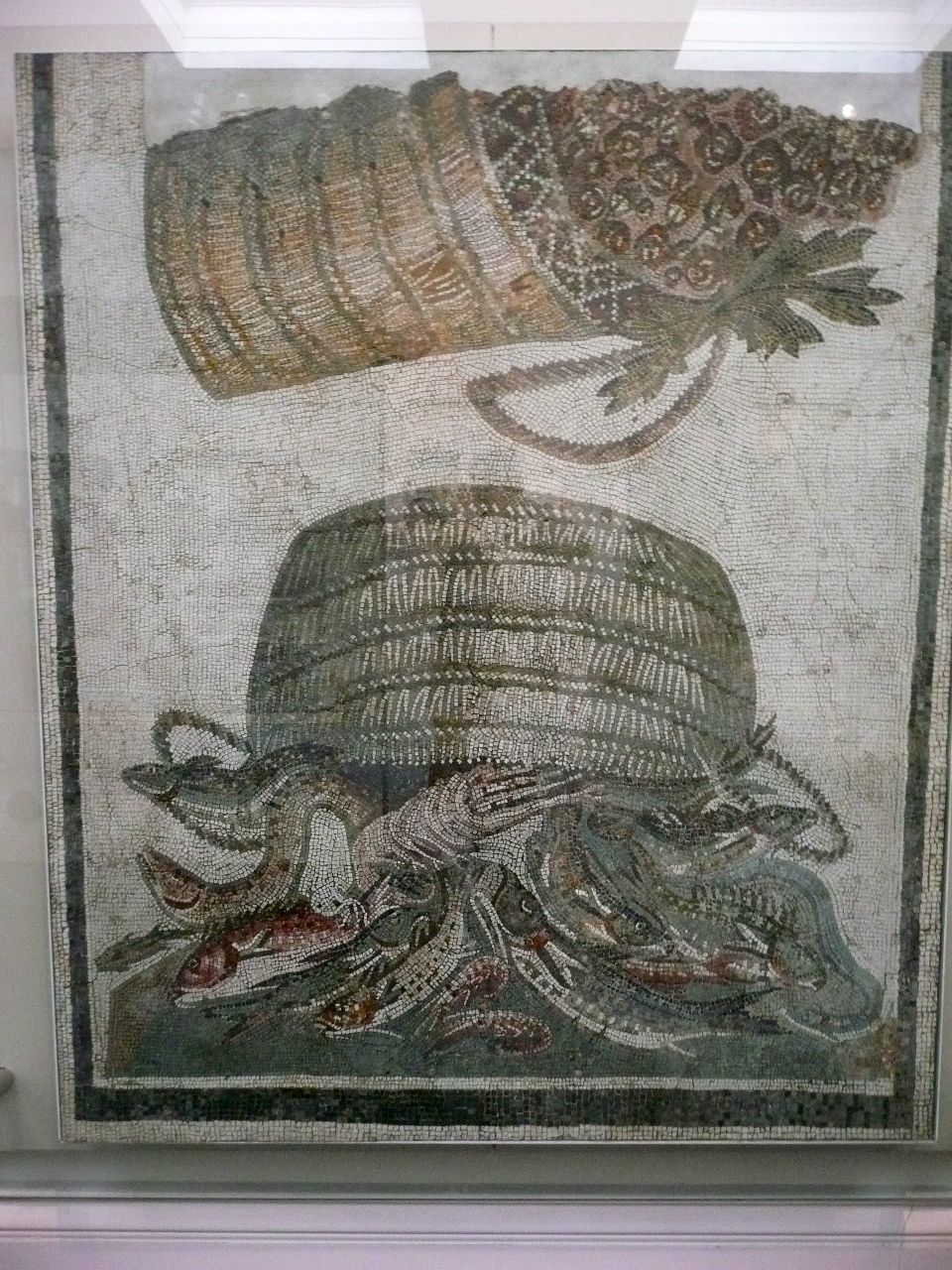
Overflowing Fish Basket. Basket above depicts an abundance of cockles and whelks. British Museum. Photo by Author
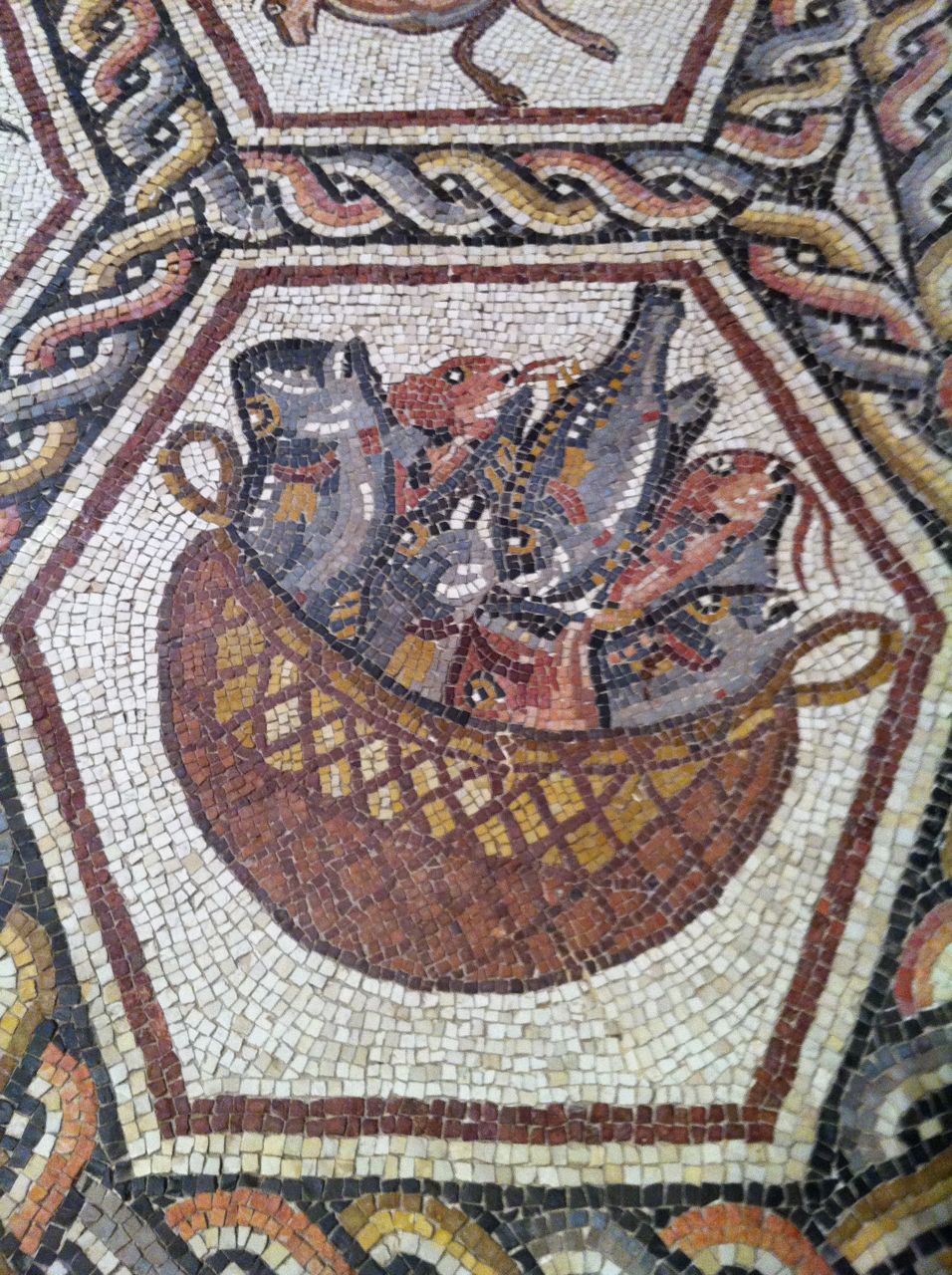
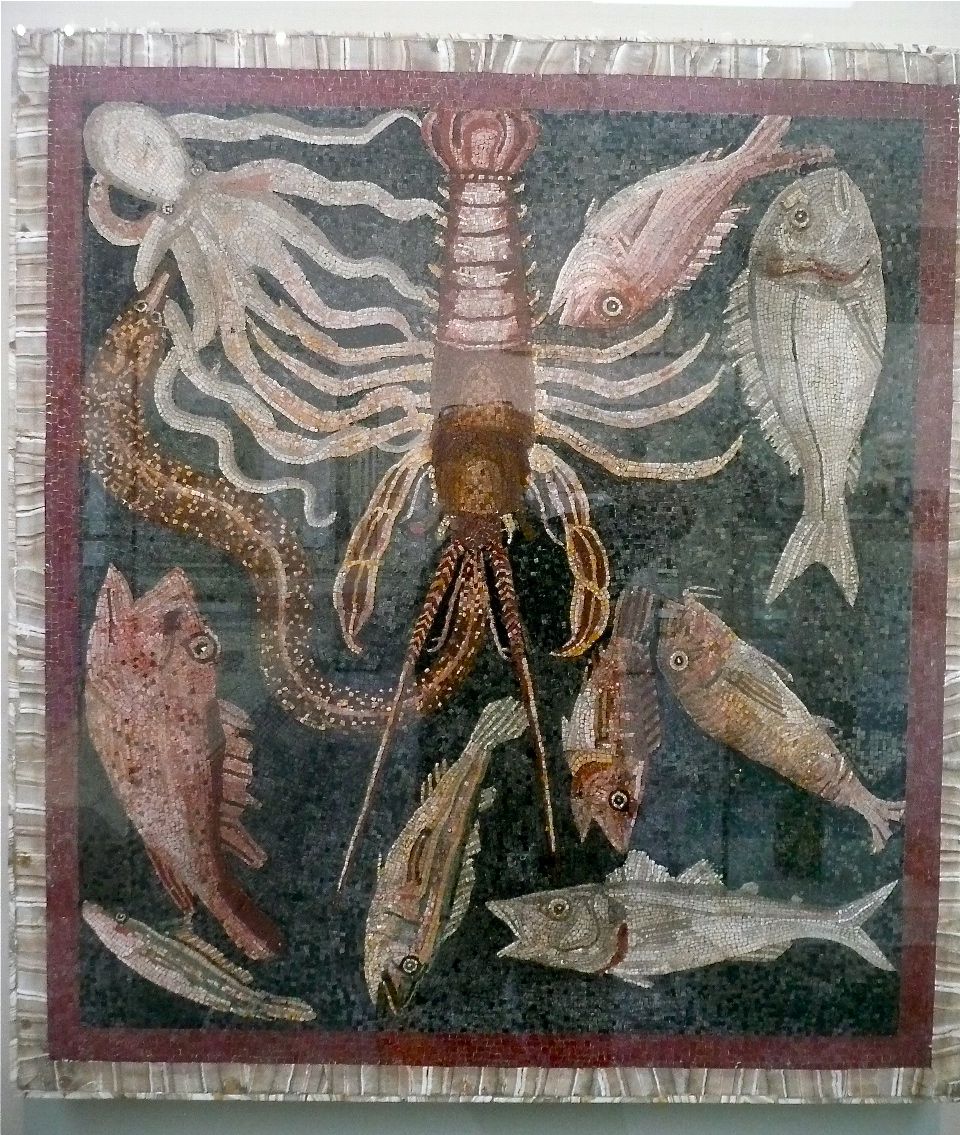
- Highly detailed Roman era pavement mosaic…For the Seafood Lover in You. British Museum. Photo by Author
Certainly, as Lightfoot points out, one of the main food staples for the Roman diet would have been fish. The bounty of the sea was eaten fresh by those located near the seaside, and certainly dried fish was used in the form of fish sauces, packed for long treks as a source of protein and shipped to inland regions of the Roman Empire.
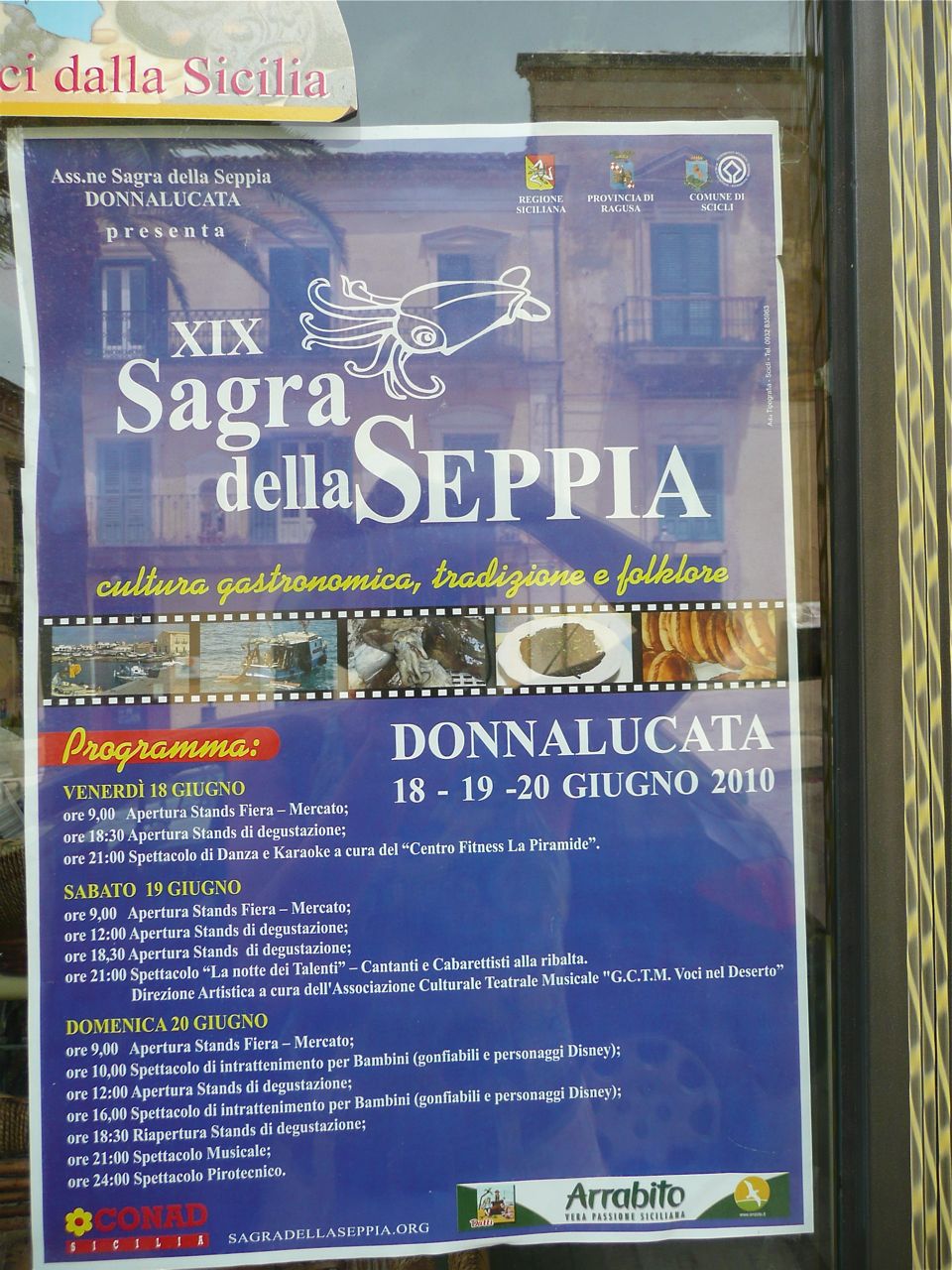
An ongoing reverence for Sea Creatures: Festival of the Squid, Sicily, 2010. Photo by Author
THE ANCIENT FISHERMEN navigated the mysterious and chimerical sea, bobbing in (mostly) tiny boats, using simple nets, hook, line and pole. If one delves into the epic myths and stories of the sea, they are rife with imminent peril. Roman villas were embellished with a variety of marine gods such as Oceanus and Neptune, and the half-horse-half-fish known as a hippocampus, and other seafaring creatures.
To this day, there are Madonnas placed seaside to protect fishermen from the dangers of the deep sea and, maybe even giant groupers.

Seaside Madonna to Protect Fisherman, Sicily 2010. Photo by Author
Watch for more articles about the fascinating LOD MOSAIC in upcoming posts…
RESOURCES
http://fieldmuseum.org/happening/exhibits/lod-mosaic-0
http://news.discovery.com/history/ancient-mosaics-marine-conservation-110913.html
http://www.futurity.org/science-technology/mosaics-tell-100000-year-old-fish-tale/
http://news.stanford.edu/news/2011/september/grouper-art-research-090211.html
Paper by Paolo Guidetti, and Fiorenza Micheli from Frontiers in Ecology:
http://www.esajournals.org/doi/abs/10.1890/11.WB.019
.




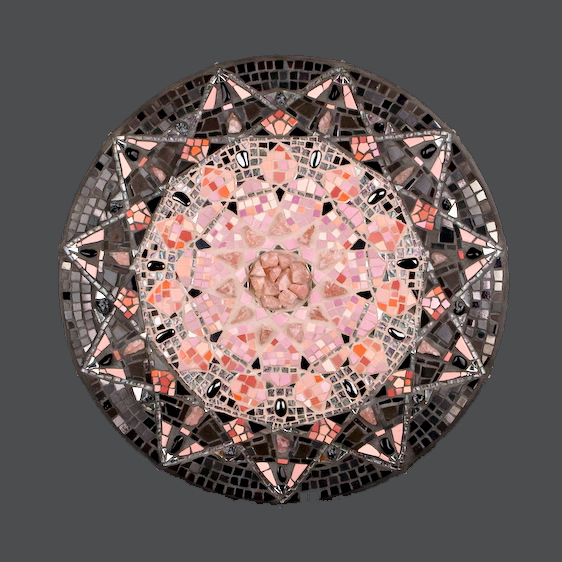
Fascinating!
The pictures are very interesting, combined with text it is a really great read.
thank you! i also enjoy your blog and drawings. thanks for checking in here at the Mind’s Eye
Thanks M.A. we meet again at the intersection of science and ancient art
I saw the exhibit at the Metropolitan Museum of Art in NY. It is an incredible mosaic piece. Thanks for sharing this.